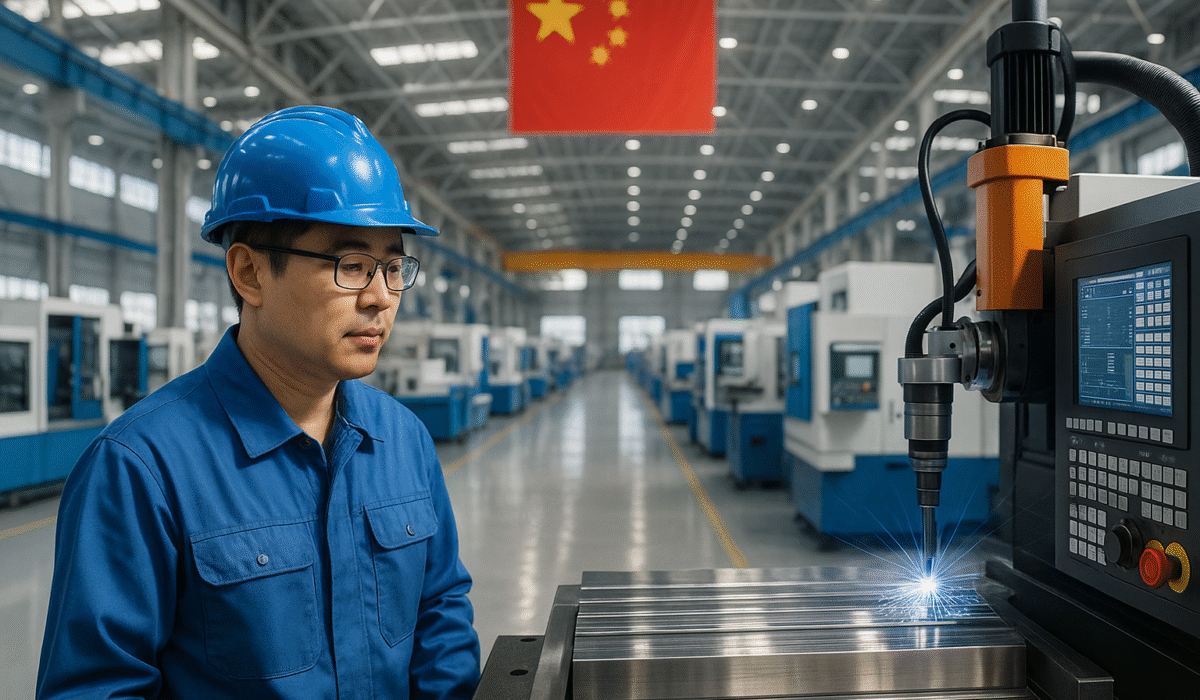⏱️ Reading time: 9 min
Key Points for Why China Leads Global Manufacturing in 2025
- China dominates global manufacturing through scale, specialization, and digital innovation, not just low labor costs.
- The country’s industrial clusters and AI-powered factories enable faster design-to-production cycles than any other market.
- Advanced logistics, export infrastructure, and compliance standards make China the most reliable supply-chain hub worldwide.
- With the rise of OEM, ODM, and private-label production, China has shifted from “world’s factory” to “world’s innovation partner.”

The reason why China leads global manufacturing is rooted in a combination of industrial scale, technological investment, and ecosystem maturity. Its vast supplier networks, efficient logistics, and advanced smart factories allow for unmatched speed, quality, and flexibility.
Over the years, China has evolved from low-cost mass production to innovation-driven custom manufacturing, dominating sectors like EVs, batteries, and renewable energy. Supported by AI, automation, and government-backed modernization programs, China continues to refine its global manufacturing supremacy — becoming not just the world’s largest producer, but also one of its most innovative manufacturers.
able of Contents
China’s Manufacturing Power: The Engine of Global Production
China’s manufacturing dominance isn’t accidental—it’s the result of decades of strategy, infrastructure, and ecosystem development.
When people ask why China leads global manufacturing, the answer lies in a perfect blend of cost efficiency, technological advancement, supply chain depth, and government-backed industrial focus.
This article highlights 10 reasons why China leads global manufacturing.
1. The Scale and Specialization Advantage
China’s manufacturing strength begins with scale.
No other nation has such a dense concentration of industrial clusters, each specializing in specific products.
Electronics dominate the Greater Bay Area, textiles thrive in Zhejiang, and heavy machinery runs through the Yangtze River Delta.
This cluster effect creates lightning-fast collaboration between component suppliers, engineers, and logistics providers—all within the same region.
The Power of Proximity
Factories, mold makers, packaging suppliers, and logistics providers often exist within a few kilometers of each other.
That proximity means design iterations happen in days, not months, and production scaling is smoother and cheaper than in decentralized markets.
2. Cost Efficiency Beyond Labor
One of the biggest misconceptions about why China leads global manufacturing is that it’s all about cheap labor.
That hasn’t been true for years.
While wages remain lower than in most Western countries, China’s cost advantage today comes from efficiency and integration—not wages alone.
More Than Labor: An Ecosystem of Cost Control
- Supplier Networks: Massive supplier bases for components, raw materials, and sub-assemblies.
- Tooling Infrastructure: Molds and dies can be made locally, quickly, and cheaply.
- Logistics Density: Multiple major seaports and express routes reduce freight time and cost.
- Government Incentives: Lower taxes, export rebates, and simplified trade zones.
The result: Not just lower unit costs through economies of scale and optimized supply chains but also a critical reason for why China leads global manufacturing.
3. “Made in China 2.0”: Moving from Quantity to Quality
China is no longer just “the world’s factory.”
It’s transforming into a global innovation and manufacturing hub through automation, smart factories, and clean energy production.
High-Tech and Smart Manufacturing
Government initiatives like “Made in China 2025” aim to upgrade manufacturing toward advanced fields—robotics, aerospace, electric vehicles, and renewable energy.
Today, China dominates the world in:
- 75% of lithium-ion battery production
- 80% of solar module output
- Leading global EV and robotics production
These figures prove that China’s edge is no longer low-cost labor—it’s technological leadership and intelligent automation.
4. The Export Flywheel: Built for Global Demand
Over the past two decades, China’s net exports of manufactured goods have grown more than 25 times making another reason for why China leads global manufacturing. This export flywheel creates continuous reinvestment into infrastructure, port expansion, and advanced logistics—fueling even faster global delivery.
Infrastructure That Moves the World
- World-Class Ports: Shanghai, Ningbo, and Shenzhen handle more cargo than most regions combined.
- Rail and Air Connectivity: Fast routes linking inland factories to global shipping hubs.
- Digital Trade Systems: AI-driven customs and export management for speed and accuracy.
When other nations still plan logistics, China’s supply chain is already moving. Even BYD recently built purposed ships for transport of their vehicles, which fully automatically moves the cars in and out of it, and they plan to build more. While many companies play key role in developing China as industrial hub, BYD, Huawei, Xiaomi, Higrow, are the names that make reasons for why China leads global manufacturing.
5. Innovation Built Into the Supply Chain
China treats AI and data as part of its industrial infrastructure. In view of Chinawholesalehub analyst, Danish, supply chain innovation is the 5th most important reason for why China leads global manufacturing.
In China, factories now use predictive analytics for machine maintenance, computer vision for quality checks, and IoT sensors for tracking production in real time.
This digital transformation turns manufacturing into an intelligent, self-improving system.
AI as the Operating System of Manufacturing
Smart systems monitor material flow, power usage, and defect rates, adjusting automatically to improve efficiency.
This digital layer makes China’s manufacturing both faster and greener—an advantage few countries can match.
6. The Real Drivers Behind China’s Success
Beyond cost and technology, why China leads global manufacturing comes down to four fundamentals:
- Massive domestic demand: Factories can scale quickly because they also serve China’s 1.4B consumers.
- Integrated supply chains: Every component—from microchips to packaging—is available locally.
- Efficient logistics and ports: Streamlined movement from factory floor to ship deck.
- Government coordination: Long-term planning and infrastructure investments ensure steady industrial growth.
Together, these elements form a self-sustaining ecosystem unmatched anywhere else in the world.
7. The Myths About “Cheap China Manufacturing”
Myth #1: It’s Only About Low Wages
Even with rising wages, China’s output per worker and automation levels have kept it globally competitive.
Efficiency, not cheap labor, drives its dominance.
Myth #2: Quality Is Compromised
Modern Chinese factories now meet or exceed Western quality standards, backed by ISO9001, CE, RoHS, and FDA certifications. It simply depends on what you demand them and what is your budget.
Myth #3: Innovation Happens Elsewhere
With AI-driven factories, smart robotics, and homegrown R&D, innovation happens inside China’s manufacturing clusters—not outside them. Out of 10, every 3rd company is investing into innovation in some way, resulting in formation of a support why China leads global manufacturing.
8. Challenges and Opportunities Ahead
Even as China leads global manufacturing in early 21st century, it faces new realities:
- Rising wages and costs push some production toward Southeast Asia.
- Trade tensions create volatility in export markets.
- Technological dependencies (like advanced semiconductors) still exist.
Yet, China adapts faster than competitors—investing heavily in AI chips, EV batteries, and automation to stay ahead of the curve.
The “China + 1” Reality
Even as companies diversify production, most still rely on Chinese tooling, components, or assembly. Essentially, why china leads global manufacturing sector also lies in its smart thinking, reduced corruption, and ability to convert challenges into opportunities.
In 2025, China remains the hub where global manufacturing supply chains converge.
9. Why It Matters for Importers and Global Brands
Out of many reasons, the 9th reason why China leads global manufacturing lies in the fact that China’s manufacturing environment offers:
- Shorter DFM → Prototype → Production cycles
- Reliable AQL quality control systems
- Strong OEM/ODM expertise for custom product development
- Proven logistics through DDP, FOB, or CIF shipping models
This ecosystem empowers brands to scale faster, reduce cost, and maintain quality — all within one country.
10. The Future: From Factory to Innovation Partner
The future of global manufacturing isn’t just about where goods are made — it’s about who can innovate fastest.
China’s ability to connect engineering, production, and logistics under one digital framework gives it a decisive advantage for decades to come.
That’s why China continues to lead global manufacturing — and why it’s evolving from “the world’s factory” into “the world’s innovation engine.”
Conclusion
Why China leads global manufacturing today has reasons and China’s rise to the top of global manufacturing isn’t a coincidence — it’s the result of decades of strategic development, engineering expertise, and supply-chain integration. The combination of local production depth, rapid prototyping, strict quality standards, and AI-enabled efficiency makes China an indispensable hub for global trade.
As industries worldwide push for smarter, greener, and faster production, China’s role is evolving from a mass producer to a global innovation partner. For businesses aiming to create, customize, or scale products efficiently, China remains the center of the world’s manufacturing future.
❓ Frequently Asked Questions
1️⃣ Why China leads global manufacturing?
Because it combines large-scale infrastructure, efficient supplier networks, advanced technology, and a government-supported manufacturing ecosystem unmatched by any other country.
2️⃣ Is China’s manufacturing still based on cheap labor?
No — modern China’s competitiveness comes from automation, AI, and integrated supply chains, not just low labor costs.
3️⃣ What industries does China dominate?
China leads in electronics, automotive (EVs), solar, textiles, batteries, and machinery, and continues to expand into aerospace and robotics.
4️⃣ How does China ensure product quality?
Through strict compliance (ISO, CE, RoHS, FDA standards), AQL inspection protocols, and digital quality-control systems across production lines.
5️⃣ What is the future of China’s manufacturing sector?
A shift toward smart factories, green production, and AI-driven logistics, making manufacturing faster, cleaner, and more innovative.
🏭 About China Wholesale Hub
China Wholesale Hub helps international brands and importers turn ideas into reality through product sourcing, OEM & ODM manufacturing, quality control, and logistics coordination across China.
With verified factory networks, transparent cost management, and end-to-end production supervision, we make custom manufacturing in China simple, secure, and scalable.
👉 Learn more: Custom Production Services in China →

